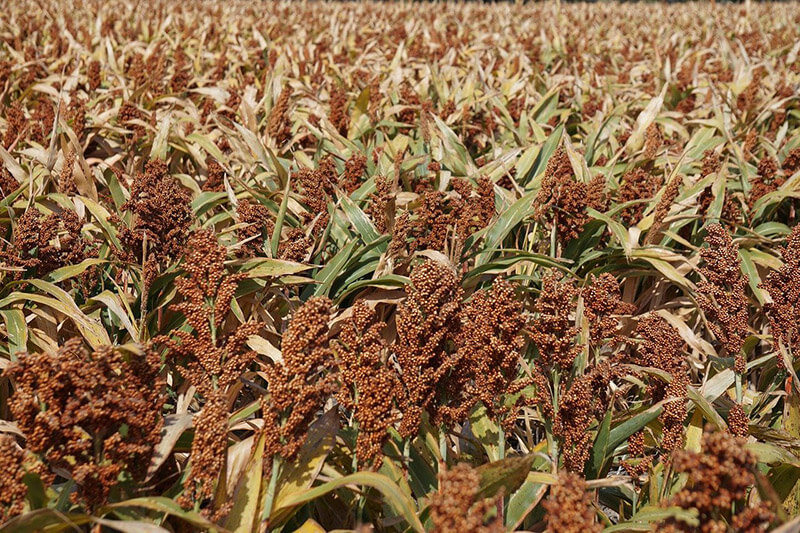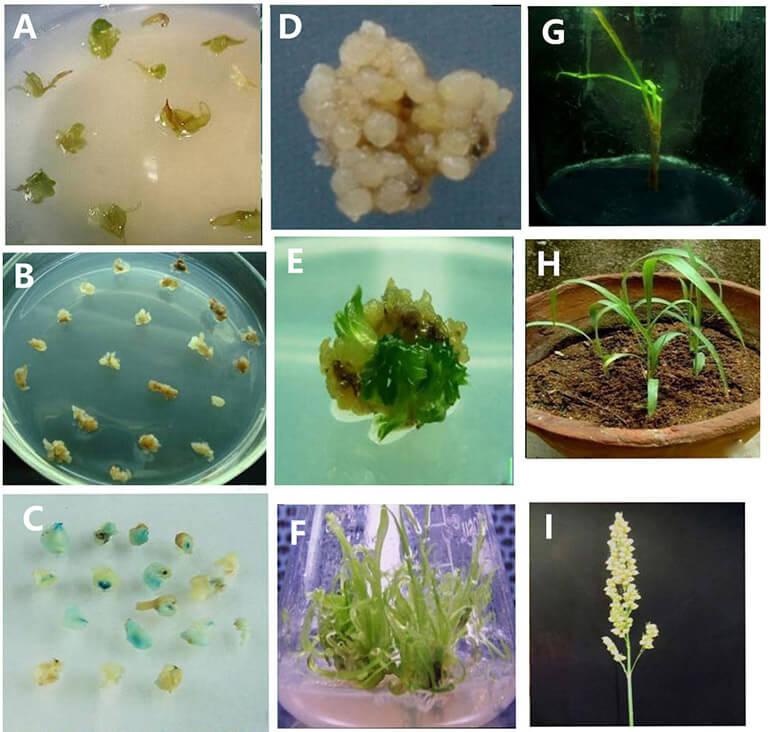Sorghum bicolor (L.) Moench, also known as sorghum, is an annual herb of the Gramineae family. It is distributed in tropical, subtropical, and temperate regions. Sorghum grains can be processed into sorghum rice, they can also be ground into flour and then made into various foods, like noodles, pancakes, and steamed cakes. Sorghum bicolor (L.) Moench is rich in vitamins and minerals. The content of pantothenic acid, niacin, and biotin is more than that of corn. In addition to being eaten as food, sorghum can also be used to make starch, sugar, wine, alcohol, etc. In order to further improve the quality and applicability of sorghum, many genetically modifications have been applied. Many sorghum varieties with good traits such as high yield, strong stress tolerance, and rich nutrients.

Lifeasible provides one-stop services, covering all steps including experimental design, vector construction, plasmid transformation, positive transplant screening and of transgenic Sorghum bicolor (L.) Moench characterization, our various genetic modification services are as follows:
Gene overexpression is an efficient tool for studying gene function. The development and utilization of gene overexpression technology has brought us many conveniences to study gene function and improving the yield of target products. Through the quantitative overexpression of genes related to pantothenic acid, niacin, biotin, and other chemical components in Sorghum bicolor (L.) Moench, the production of specific compounds can be increased. We could help our customer overexpress many genes including drought stress response gene QTL, SbSBP5, salt tolerance gene WRKY50, oxidative stress resistance gene SbbHLH1, hormone stress gene LEA, gene FAD7 that improves cold resistance of Sorghum bicolor (L.) Moench, and many other genes related to important traits.
RNAi technology is widely used in the field of gene editing, it is a phenomenon of specific gene silencing mediated by double-stranded RNA (dsRNA) and involved in specific enzymes. It blocks gene expression at the transcription level, and post-transcriptional level. Through RNAi technology, we can achieve silencing of multiple genes in Sorghum bicolor (L.) Moench.
Virus induced gene silencing (VIGS) is a genetic technology that inhibits the expression of endogenous genes in plants by recombinant viruses containing interference fragment of target gene. The function of target genes can be studied based on phenotypic changes. The VIGS technology is a method of transient transformation and can help our customers save time and obtain valuable information for gene functional analysis. With wealth of experience in VIGS, our scientists can provide you with customized protocol for VIGS in Sorghum bicolor (L.) Moench.
CRISPR gene knockout technology is currently the most widely used gene knockout technology, it provides us with a very powerful and convenient gene editing tool. As a leading company that has been deeply involved in the field of gene editing for many years, with CRISPR technology, we can knockout Sorghum bicolor (L.) Moench genes in different ways, including frameshift mutations, multiple deletion of fragments, knockout of non-coding genes, knockout of multiple copies of genes, etc.
CRISPR system has strong scalability, and this scalability can be used to develop more useful gene editing tools. we have developed many methods that can improve gene knock-in efficiency and achieve precise editing of the Sorghum bicolor (L.) Moench genome. For the gene knock-in process, most of them is done through HDR. However, NHEJ and HDR will occur at the same time due to DNA breaks. Therefore, we have developed different methods to increase the probability of HDR, thereby improving the efficiency of gene knock-in process.
CRISPR single base editing technology is a hot area of life science research today. As a company that has been cultivating gene editing technology for decades, Lifeasible could help you achieve the conversion from C to T or A to G in Sorghum bicolor (L.) Moench using CBE and ABE, both of which rely on the sgRNA specific recognition and fusion of dCAS9 to a deaminase.
Sequence-specific control of gene expression on a genome-wide scale is an important approach for understanding gene functions and for engineering genetic regulatory systems, one of them is CRISPR Interference (CRISPRi). There are many ways to participate in the inhibition of gene expression. For the inhibition of Sorghum bicolor (L.) Moench genes, we can provide a variety of solutions, including dCas9 binding to targeted DNA and realizing Inhibition of gene transcription through steric hindrance. In addition, gene knockdown can also be achieved by recruiting a fusion protein to the start site of gene transcription.
CRISPRa technology uses the powerful capabilities of Cas9 and sgRNA to fuse or recruit multiple proteins to enhance gene transcription. For Sorghum bicolor (L.) Moench genes, we provide VPR technology, SAM technology and Suntag technology to allow the CRISPR system to carry more activation element and achieve a stronger activation effect after synergistic amplification.
The study of gene function has always been the core subject of biological research. The earliest genetic screening system established through forward genetics is very inefficient and has a huge workload. However, the reverse genetic screening system based on CRISPR technology can complete very low-cost mutation library construction work. The gene mutation library construction technology we provide for Sorghum bicolor (L.) Moench including gene knockout library construction, gene knockdown library construction, and gene activation library construction. Moreover, single-cell sequencing is available for mutation screening.
DNA-free gene editing technology has received extensive attention from the industry in recent years. We provide DNA free Sorghum bicolor (L.) Moench genome editing services, including transient expression of CRISPR/Cas9 plasmid DNA, in vitro transcription of CRISPR/Cas9, and pre-assembled ribonucleic acid composed of purified Cas9 protein and sgRNAs complex. These technologies can avoid the integration of foreign DNA and genome, and reduce off-target effects. In addition, compared with traditional techniques, these techniques can avoid the use of hybridization or backcrossing to isolate CRISPR/Cas9 chimeras, so they are cheaper and have shorter experimental cycles.
Genetic Transformation Process for Sorghum bicolor (L.) Moench
The most advanced and widely used method for the development of genetically modified Sorghum bicolor (L.) Moench is Agrobacterium-mediated transformation. The foreign target gene is transferred and integrated into shoot apex explants by Agrobacterium infection, and then transformed plants are regenerated using specific medium.
 Figure 1. Transformation and regeneration of Sorghum bicolor (L.) Moench, (A) Shoot apex explants of sorghum after infection with Agrobacterium LBA4404, (B) Hygromycin resistant calli of sorghum after 42 days of cocultivation in selection medium, (C) The transient expression of GUS gene in the calli of sorghum after cocultivation with Agrobacterium LBA4404 for ten days, (D) Hygromycin resistant embryogenic calli of sorghum on regeneration medium, (E) The proliferation of hygromycin resistant shoots of the sorghum after further subculture to selection medium, (F) Proliferation of hygromycin resistant plants of the sorghum cultivar after further subculture on regeneration medium, (G) Rooting of hygromycin resistant plants of the sorghum cultivar on rooting medium, (H) Transformed sorghum plants at in vivo conditions, (I) Panicle of transformed sorghum plants. (Ignacimuthu S, et al. 2014)
Figure 1. Transformation and regeneration of Sorghum bicolor (L.) Moench, (A) Shoot apex explants of sorghum after infection with Agrobacterium LBA4404, (B) Hygromycin resistant calli of sorghum after 42 days of cocultivation in selection medium, (C) The transient expression of GUS gene in the calli of sorghum after cocultivation with Agrobacterium LBA4404 for ten days, (D) Hygromycin resistant embryogenic calli of sorghum on regeneration medium, (E) The proliferation of hygromycin resistant shoots of the sorghum after further subculture to selection medium, (F) Proliferation of hygromycin resistant plants of the sorghum cultivar after further subculture on regeneration medium, (G) Rooting of hygromycin resistant plants of the sorghum cultivar on rooting medium, (H) Transformed sorghum plants at in vivo conditions, (I) Panicle of transformed sorghum plants. (Ignacimuthu S, et al. 2014)
Lifeasible offers our customers with professional one-stop services, covering whole process including experimental design, vector construction, plasmid transformation, positive transplant screening and testing. For more information or any inquiry requirements, please contact Lifeasible.
Reference